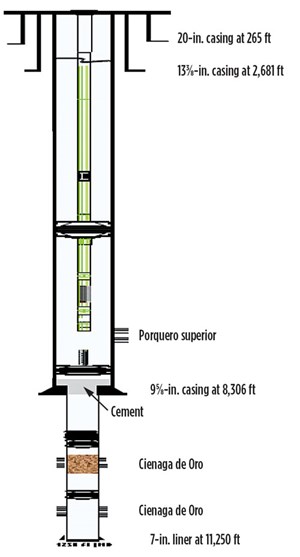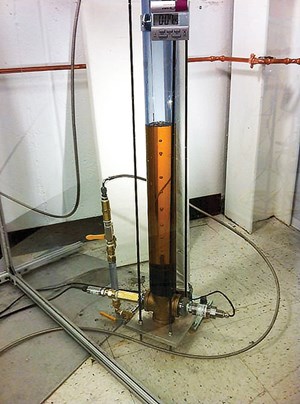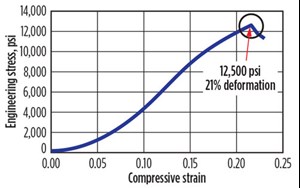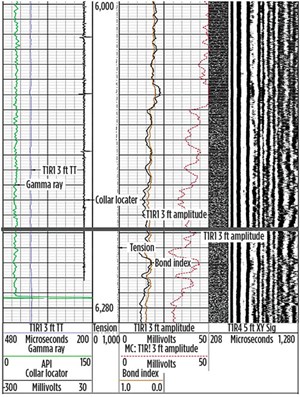Resin system facilitates shut-off of difficult gas well
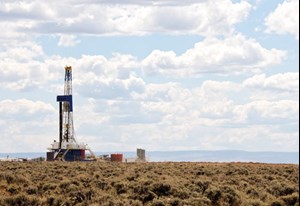
Recent studies have shown an increase in the percentage of wells affected by sustained casing pressure, over time. Both the oil and gas industry, and governments, are studying the causes of sustained casing pressure, and methods to help prevent undesired flow that can, potentially, result in the loss of wellbore integrity and environmental problems.
In northern Colombia, natural gas fields have been developed for decades. However, as a result of mechanical problems, or low economic return rates, some producing wells have been abandoned. Some of the wells were abandoned using conventional cementing techniques without success, resulting in gas communication, through the annulus, to the surface. In some cases, this even has been observed where the primary top of cement (TOC) was planned to surface.
Potential gas communication through the wellbore annulus has long been an issue for the upstream industry. Several factors—such as flow through mud channels, micro-annuli, and flow through unset cement, among others—influence gas communication.
This article examines the application of a new resin, with superior mechanical properties and solids content, designed in accordance with the needs of the well. This resin is able to penetrate areas previously inaccessible to conventional cement slurry, such as small fractures, channels or microannuli. The following case study illustrates how a sustained casing pressure problem was caused by a channel in the primary cement job.
The new resin system was pumped, as a squeeze job, ahead of neat cement slurry, to isolate the gas-producing formation; no further gas production was observed at surface, bringing the well back into compliance with regulations for proper well abandonment.
INTRODUCTION
Annular gas flow has been a problem for many years in the upstream industry. When a series of barriers fails, and a path leak is formed, gas is the most common fluid lost.3 Annular flow is defined as the flow of formation fluids—liquids and/or gases—into a space or pathway in an annulus, within a well. The annular flow can follow various types of flow paths, inside the annulus, to other points. The flow might exit the annulus and enter another formation(s), or continue along the annular flow path, or both.1
The various causes of gas channeling, through a cemented annulus, can be classified according to when they occur:
- Gas migration during placement (immediate)
- Gas migration post-placement (short-term)
- Gas migration after cement set (long-term).
Understanding and modeling gas migration is difficult, because there are several potential flow paths, or combinations of flow paths. These include:
- Along the formation and cement interface
- Along the casing and cement interface
- Through unset cement by percolation of gas bubbles
- Through the microstructure of unset cement
- Through channels in unset cement
- Through unset cement in underbalanced conditions
- Through cracks in set cement
- Through any combination of these.
The three main reasons for gas migration are 1) the remains of mud cake between the cement and the permeable formation can provide a weak zone and thereby a future flow path; 2) the hydrostatic pressure in the annulus falls to less than the pore pressure, allowing gas influx into the unset cement, potentially resulting in channels; or 3) the cement fails as a barrier—such as the inability of the cement to hold high fluid pressure during the transition time period, or when a microfracture caused by stresses creates a flow path.
Squeeze cementing is the first option for isolating or abandoning a problematic annular zone. Squeeze cementing can be described as the process of forcing cement slurry into holes in the casing, and cavities behind the casing.5 There are, however, a number of challenges associated with squeeze cementing operations that can influence the success of a zonal isolation job.
The permeability of the formation, the presence of formation fluid (gas/oil/water), fracture gradient, well fluid, injection rate into the troubled zone, and temperature are some of the primary parameters to be reviewed when designing a fluid system and pumping technique, for a remedial strategy. Even when these considerations have been taken into account, a thorough analysis should be performed to determine the most beneficial solution, based on a cost-versus-time strategy.
In Colombia, limitations of conventional cement and wellbore conditions have resulted in some unsuccessful remedial operations for water/gas shut-off. Treatment failure can, mainly, be attributed to formation fluid contamination—caused by high pore pressure in the formation and the inability of cement particles to enter microchannels and form a seal—during the transition time of the cement slurry. Jones, et al, recently used an advanced epoxy resin for remedial squeeze operations in unconventional reservoirs, with very successful results.2 Their success was attributed to the resin’s ability to penetrate into tight spaces without the risk of particle bridging, its high compressive strength developed after curing, and its ability to be pumped in conjunction with water-based fluids, such as brine and cement. This article discusses how an advanced solids-free epoxy resin was applied for gas shut-off in a difficult-to-abandon well.
PROBLEM
Well P-1 is in the municipality of Ariguani, in the Magdalena department of the Caribbean region of northern Colombia. The well, which was drilled in 2009 and reached a total depth (TD) of 12,250 ft, was completed in four sections. The first section was drilled with a 26-in. bit, and 20-in. casing was run and cemented from 165 ft to the surface. The second section was drilled with a 17 1/2-in. bit, and 13 3/8-in. casing was cemented from 2,681 ft to the surface. The presence of gas was reported from 1,040 ft to 2,686 ft during the drilling of this section, and a concentration up to 12,524 ppm was observed in the 12-lbm/gal mud. The third section was drilled with a 12 1/4-in. bit, and 9 5/8-in. casing was run at 8,306 ft. The primary cementing operation was designed to reach cement to surface. Cement return at surface was reported after the primary cementing operation. The last section was drilled with an 8 1/2-in. bit, reaching 11,250 ft, TD. Because of some operational problems, the liner was cemented through a cement retainer set 100 ft above the 7-in. shoe.
The Cienaga de Oro reservoir (10,923 ft to 10,985 ft and 10,995 ft to 11,100 ft) was tested and subsequently abandoned using a bridge plug at 10,768 ft. The upper Cienaga de Oro zone (10,695 to 10,720 ft) was abandoned because of sand production issues. Two bridge plugs were used (10,460 ft and 8,196 ft), and each was tested at 1,000 psi for 10 min. A 15.7-lbm/gal cement plug was set at 7,840 ft. Finally, a gun system with a sand control completion was run to test the Porquero Superior reservoir, Fig. 1.
During the production history of this well, high pressure was observed in both the 13 3/8-in.–20-in. and 9 5/8-in.–13 3/8-in. annuli. Gas samples were collected from each annulus to determine the origins, obtaining the results below.
- Gas from the 13 3/8-in.–20-in. annulus was dry, with a 68% biogenic origin and had no oil associated. During the 17 1/2-in. drilling stage, the presence of gas was reported from 1,040 ft to 2,686 ft, which likely entered this zone because of a poor primary cement job.
- Gas from the 9 5/8-in.–13 3/8-in. annulus had a thermogenic origin associated with oil (same gas composition as from the Porquero reservoir.)
As a result of low commercial gas production, the operator decided to abandon the well to prevent the leakage of formation gas/fluids to the surface, from the sensitive formation. This type of permanent abandonment must be reliable to meet governmental requirements, and prevent future environmental problems.
RESIN SOLUTION
Resin chemistry—including epoxies, phenolics and furans—has been used widely in a variety of applications in well construction, completion and production.4 Epoxy resin systems are ideal for use in shutting off unwanted gas flow.
One of the main attributes of an epoxy resin system is its ability to formulate completely free of solids. This allows the system to overcome the effects of particle bridging, which are often associated with particle-laden fluids, and permits deep penetration into the affected area. For example, during a remedial squeeze operation using conventional cement, penetration of a channel is limited by the particle size of the cement. When the slurry reaches a microchannel, fluid loss occurs. A filter cake forms, and only filtrate enters the microchannel, potentially limiting the effectiveness of this approach. However, when an epoxy resin is used for a remedial squeeze, the resin effectively enters the microchannel and seals the leak. In the case of annular gas flow, where pressure is observed at the surface, a channel exists from the origin of the gas all the way to the surface, which can be thousands of feet long. The resin is able to penetrate this channel and travel for a long distance to seal the leak.
After placement, the resin transforms from a liquid to a high-viscosity liquid, to a viscoelastic solid, and, finally, to a solid, exhibiting high compressive strength with the ability to withstand high strain without failure through a crosslinking reaction. During the liquid state, the resin continuously transmits hydrostatic pressure. In Fig. 2., an underbalanced situation is simulated, where the gas pressure exceeds the hydrostatic pressure of the column of resin above. It can be observed that gas is able to bubble through the resin, but no channeling or residual flow path remains after the gas passes through, and the system is able to form a competent seal. Once cured, the compressive strength of the resin generally ranges from 10,000 psi to 20,000 psi. The magnitude of compressive strength and Young’s modulus is dependent on temperature. Figure 3 shows a stress versus strain plot for a resin cured and tested at 162°F. In this test, the resin exhibited a compressive strength of 12,500 psi. However, equally impressive is the point at which the measurement of compressive strength occurred. This occurred at a compressive strain of 21%, illustrating the ability of resins to withstand high degrees of strain.
FIELD APPLICATION
Well P-1 had been inactive since 2009 because of poor production. Gas pressure (750 psi) was observed at the surface, 9 5/8-in.–13 3/8-in. annulus. A cement bond log was taken, which indicated poor cement bonding between the casing and formation, from 6,200 ft to the surface, Fig. 4. A chromatography test and the cement bond log indicated that the gas at surface was coming from the Porquero Superior reservoir (7,804 ft to 7,834 ft).
Perforations were made across the interval from 6,053 ft to 6,058 ft in the 9 5/8-in. casing to create a communication path to the annulus. A cement retainer was run to 6,045 ft (8 ft above the upper perforation). An injectivity test was conducted, which showed a maximum pressure of 1,450 psi at 2.5 bbl/min, indicating a void space existed behind the casing.
The maximum working pressure, considering the fracture gradient and a pressure limit for the job, was established at 1,500 psi. To penetrate more deeply through microannuli, a low solids-free formulation was designed. Using a special mixer, 5 bbl of the resin was mixed in a tote tank. Fifteen bbl of 16-lbm/gal Class “G” cement with latex were mixed in a batch mixer.
Five bbl of calcium chloride brine were pumped at 3 bbl/min and 800 to 1,050 psi, as a preflush; 5 bbl of solids-free resin at 9.3 lbm/gal were pumped at 2 bbl/min and 1,100 psi; followed by 15 bbl of 16-lbm/gal Class “G” cement slurry at 3 bbl/min and 1,200 psi. Ten bbl of 15.2-lbm/gal spacer followed by 14.7 lbm/gal of water-based mud (WBM) were used as displacement fluids. Initially, the stinger was out of the retainer. Once the spacer was near the end of the string, the stinger was plugged in the retainer to activate the valve and squeeze all of the treatment fluid into the formation. All of the brine, resin, and cement were pumped continuously at 1-1.5 bbl/min below the fracture pressure until reaching the entire string displacement volume, minus 2 bbl.
After the squeeze job, the 9 5/8-in.–13 3/8-in. annulus surface pressure was monitored continuously. No gas migration was observed after 72 hr, which indicated the treatment was successful.
CONCLUSIONS
The following conclusions were achieved as a result of this study:
- A gas shut-off job was performed successfully by using a novel epoxy resin ahead of a neat cement slurry.
- Pressure decreased with time until 0 psi was reached, no gas production was observed at the surface, and the well was brought back into compliance with governmental regulations for proper well abandonment.
- It was shown that gas bubbles can pass through the resin when it is in a liquid state; however, once it sets, a competent seal is formed.
- The versatility of the system allows for the mixing of large volumes in a batch mixer or for just a few barrels in a tote tank. This presents an advantage for remote areas, offshore deepwater operations, locations with insufficient space, or in situations where the transportation of heavy equipment is prohibitive.
- Based on its properties—such as fluid immiscibility, suitable mechanical properties, its ability to be pumped in conjunction with water-based fluids (brine and cement), and high penetration capability because of the solids-free design—the resin was the preferred strategy as an annular gas shut-off system for these kinds of wells.

ACKNOWLEDGMENTS
The authors thank the management of Gran Tierra Energy and Halliburton for permission to publish this work. They also thank the engineering personnel of both companies for their contributions to this work. This article is an adaptation of SPE paper 169400-MS.
REFERENCES
- API RP 65 Part 2, Isolating potential flow zones during well construction, First edition, Washington, API, 2010.
- Jones, P.J., B.A. London, L.B. Tennison, et al, “Unconventional remediation in the Utica shale using advanced resin technologies,” SPE paper 165699, presented at the SPE Eastern Regional Meeting, Pittsburgh, Penn., Aug. 20-22, 2013.
- King, G.E. and D.E. King, “Environmental risk arising from well-construction failure—Differences between barrier and well failure, and estimates of failure frequency across common well types, locations,” and well age, SPE Prod & Oper 28 (4): 323–344, SPE paper 166142-PA, 2013.
- Morris, K.A., J.P. Deville and P.J. Jones, “Resin-based cement alternatives for deepwater well construction,” SPE paper 155613, presented at the SPE Deepwater Drilling and Completions Conference, Galveston, Texas, June 20-21, 2012.
- Shryock, S.H. and K.A. Slagle, “Problems related to squeeze cementing,” J. Pet Tech 20 (8): 801–807, SPE paper 1993-PA, 1968.
- What's new in production (February 2024)
- U.S. operators reduce activity as crude prices plunge (February 2024)
- U.S. producing gas wells increase despite low prices (February 2024)
- U.S. oil and natural gas production hits record highs (February 2024)
- Dallas Fed: E&P activity essentially unchanged; optimism wanes as uncertainty jumps (January 2024)
- Enhancing preparedness: The critical role of well control system surveys (December 2023)
- Applying ultra-deep LWD resistivity technology successfully in a SAGD operation (May 2019)
- Adoption of wireless intelligent completions advances (May 2019)
- Majors double down as takeaway crunch eases (April 2019)
- What’s new in well logging and formation evaluation (April 2019)
- Qualification of a 20,000-psi subsea BOP: A collaborative approach (February 2019)
- ConocoPhillips’ Greg Leveille sees rapid trajectory of technical advancement continuing (February 2019)

